|
Low-floor tram A low-floor tram is a tram that has no steps between one or more entrances and part or all of the passenger cabin. The low-floor design improves the accessibility of the tram for the public, and also may provide larger windows and more airspace.[1] A low-floor tram allows accessible level access from curb level platforms. Level access can also be achieved either by using a high-floor vehicle serving high-platform stops. Currently both types are in use, depending on the station platform infrastructure in existing rail systems. Some systems may make use of former railway alignments where use of existing high platforms is desirable, while others, particularly new systems, may not have the space to site high-level platforms in urban centres. Low-floor tram configurationsTrams traditionally had high floors, and articulated tram designs evolved with low-floor centre sections. Examples of this design are Amsterdam 11G/12G-trams and the Kusttrams in Belgium. The most common design of 100% low floor vehicles[citation needed] is the multi-articulated design. This uses short carbody sections for the wheels with longer sections between them. Examples of this are the Alstom Citadis and Combino. A different design was developed by MAN. In 1990 the GT6N was the first 100% low-floor tram. These trams are found in ten German cities (such as Bremen and Munich) and in the Swedish city Norrköping. Other designs are only partially low floor, with high floors over the bogies at the outer ends and single axle bogies under the low-floor centre section. North American light rail type vehicles frequently have a similar configuration but with a centre bogie designed to accommodate a low floor situated under a short centre section. In Vienna, Ultra Low Floor (ULF) Trams can "kneel" at the curbside, reducing the height from the road to only 180 mm (7.1 in).  Some public transport companies have both low floor and high floor trams. They report that low floor trams have 15% higher maintenance costs for the rolling stock, and 20% higher maintenance costs for the infrastructure on average.[2] Many low-floor trams have fixed bogies[3] which increase track wear and tear, while decreasing the speed at which a tram can drive through a curve (usually 4–15 km/h (2.5–9.3 mph) in 20 m (66 ft) radius curve).[4] The Škoda ForCity and the newest Alstom Citadis X04 try to counter the effect with pivoting bogies while maintaining 100% low floor design. Prior to the new design, pivoting bogies could only be used under high floors, hence such trams could only be part low-floor, with high-floor sections over the pivoting bogies. Historic examples The idea of a low-floor tram dates back to the early 20th century when a number of trolley systems began experimenting with various "stepless" designs. Perhaps the most notable is the Hedley-Doyle Stepless car introduced in 1912 for use on Broadway in Manhattan.[5] A number of other cities also purchased Hedley-Doyle Stepless trams after seeing their success in Manhattan. Since these cars had a unique appearance compared to any other trams running at the time, they earned a number of nicknames, including hobble skirt cars, public welfare cars, and sow bellies.[6] Typical floor heightsTypical floor heights of low-floor trams are 300 to 350 mm (11.8 to 13.8 in), and the Ultra Low Floor tram has a floor height of only 180 mm (7.1 in). For comparison high-floor trams are typically more than 600 mm (23.6 in) and rapid transit using heavy rail trains has floor heights of 800 to 1,200 mm (31.5 to 47.2 in). List of low-floor trams by country manufactured and manufacturersBelarus
Canada 
Croatia
Czech Republic


France
Germany

 Italy
Japan
Poland

Romania
Russian Federation 
Spain
Switzerland

TurkeyUkraine Other trams
See alsoReferences
External links
|

